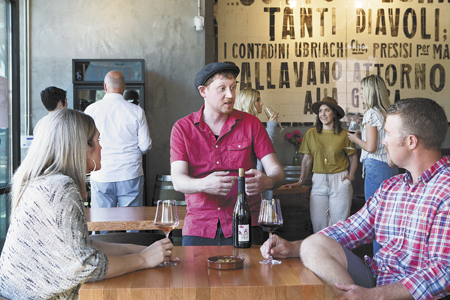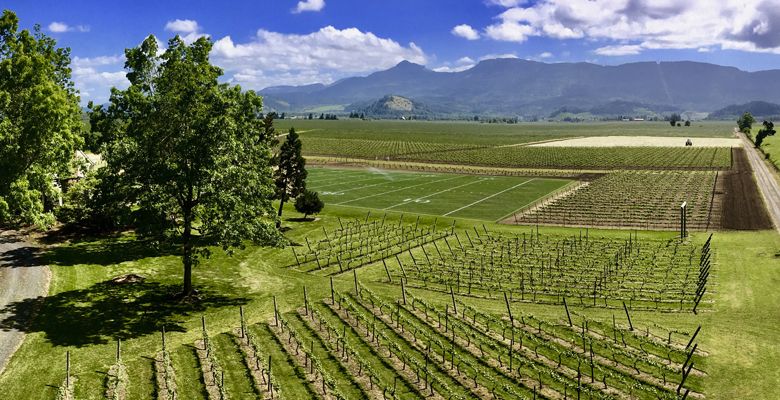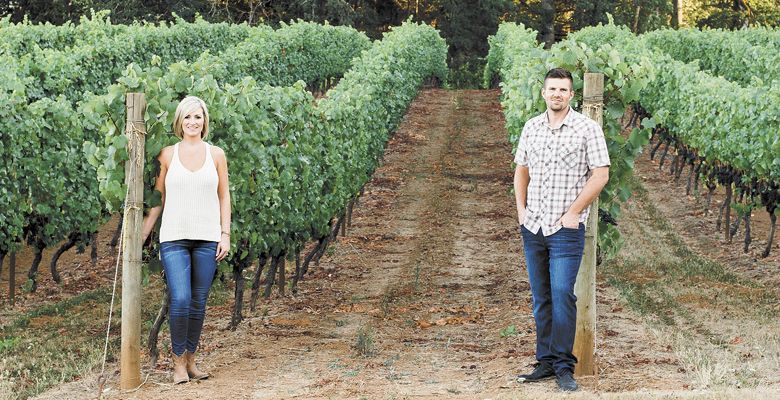Below the Fold
Southern Willamette wineries aim for the top
Picture the Willamette Valley as a full-size newspaper, the large broadsheet folded in two across the middle. Below the crease are stories worthy of the front page but lacking the assured “punch” of those above with headlines designed to grab your attention. Even on a stack of earliest editions, the ink nearly dry, the southern stories remain out of sight until further examination.
While a valley isn’t a newspaper, the analogy works. In the Willamette Valley AVA, the media focuses most attention on the northern half, where simply more wineries exist along with the state’s largest city exists, too. Winery folks in and around Lane County — about 70 in all — have few illusions about these proximal challenges. So, like Avis, they try harder.
Iris Vineyards proprietor Richard Boyles sums it up for most South Willamette growers and wine producers. “Our biggest challenge is demographic [and] geographic. Proximity to Portland’s population and international airport benefits the northern Valley wineries. Tasting rooms within an hour’s drive of Portland simply get more traffic, more exposure, more word-of-mouth and more press by virtue of Portland’s population base.
“PDX (airport) provides a similar benefit,” Boyles continues. “Many out-of-state travelers start their exploration of our state by flying into PDX rather than Eugene, Medford or Bend/Redmond. They may make Portland their base and include some day trips, [but] it takes some extra curiosity to motivate those travelers to go beyond the tasting rooms within an hour of Portland.”
Matt LaVelle of the eponymous Elmira winery explains in simpler terms, “There are more people in the [northern] Valley and more money,” Still, like Boyles, he feels the larger industry agencies, such as the state’s Oregon Wine Board are helpful.
I consider the fold situated somewhere between Willamette Valley Vineyards in Turner and the newly opened St. Innocent in nearby Jefferson. I’m not alone. Danuta Pfeiffer, co-owner of Pfeiffer Vineyards in Junction City, made a plea in the December 2018 of Oregon Wine Press to media outlets, specifically Wine Enthusiast, which printed a map labeling the Willamette Valley as a region existing from Portland to just south of Salem.
She says in the op-ed, “I can understand how metropolitan Portland and Salem area wineries and vineyards garner most of the attention, tourists and razzle-dazzle, with six times the number of vineyards and five times the number of wineries than the south, but I suggest that in the South Willamette Valley, we are the hidden gems that have every bit the quality, hospitality and razzle-dazzle as our northern cousins.”
The national wine press generally visits and writes about wines in the Valley downstream — that’s right, the southern point of the river actually forms its headwaters. To the contrary, Dan Berger of the Napa Register inclines to focus on wines from the Umpqua Valley; this is outside the territory concerning this story, yet, the fact does bring up questions: Why is the southern part of Willamette Valley not getting the attention? What kind of marketing support comes from independent and state-sponsored associations like the Willamette Valley Wineries Association and Oregon Wine Board? What am I missing by missing these area wines? That is, what do they offer?
Eugene is surrounded by farming communities. The snowmelt from the Cascades rumbles along the McKenzie River through caverns to the upper Willamette River. This great sustainable water and power combination explains how the surrounding farms produce with élan.
For example, Noble Estate, where Godzilla power lines actually improve the woodlands, all surrounding the tasting room — unless you’re a Luddite, one cannot but admire the coexistence of these opposing totems of purpose somehow working together. The place, authentically pastoral, contains real people who grow crops and cultivate the land.
Iris Vineyards’ Boyles and Pamela Frye grew up on farms in Southern Oregon where homemade wine caught their fancy. Owners of nearly 1,000 acres in the coastal hills near Eugene, growing grapes in a scenic vineyard called Chalice, Boyles’ day job entails ownership and management of 20 hotel properties serving wine tourists and, more important, all the traffic a major university draws to Oregon’s third most populous city. The couple has thus married wine to hospitality, and continues doing so.
A fifth-generation grass seed farmer, Russ Hayworth of Hayworth Vineyards in Coburg also serves on the board of the South Willamette Wineries Association. Its members, he says, are cooperative “being farmers,” but adds their biggest challenge “is not finding agreement, but time to do everything.” The group will need it August 18, when SWWA members pour wine together on, of course, a regulation football field in the middle of a vineyard. The gridiron is no fetish; Hayworth Seed grows into turf wherever pro teams tussle — nice gig. Find more details about Wine Fest! Vintage 2019 at eventbrite.com.
The region’s horn receives regular “tooting” from Julia Crowley, general manager at Hayworth, as she hosts a weekly wine show on KPNW news radio. She covers the local scene, indeed, but her guests and topics encompass the entire state industry.
If there is any discomfort with statewide industry support, it is not about the will to act. It’s about patience and having enough time. This is the theme the executive director of the Willamette Valley Wineries Association, Morgen McLaughlin, convincingly makes:
“It’s important to keep in mind that the Willamette Valley is only a 50-year-old wine region. Every young region begins somewhere, and when David Lett identified the Valley as an ideal setting for Pinot Noir in the early 1960s, his choosing of the Dundee Hills as his particular locale was a vote of confidence in the region as a whole. With its proximity to Portland to the north and Salem to the south, and the towns of Dundee, Newberg and McMinnville in the middle offering the first glimpse of a true “wine country” tourist destination, it’s not hard to see why the North Valley was a convenient place to undertake the gargantuan task of starting a wine region from scratch. Of course, a critical mass developed around his first plantings; when you are a pioneer winegrower in uncharted territory, you have to build infrastructure from the ground up, and folks tend to plant fairly close to each other so they can share equipment, experience, and camaraderie. This explains how our first half-century of wine history developed with the Dundee Hills as its epicenter — pioneers like King Estate did not establish in the South Valley until the early ’90s, and, in fact, the Valley expanded its southern borders as recently as 2016 — but as we are already seeing, the development that has spread from there is projected to take advantage of the full potential of this 3.5-million-acre region.”
Finally, we can consider some of the wines produced here and their stories in brief, for it is the wine that must allure people, and it is wine that will build brand loyalty.
Tom Kokkeler comes from grass seed farming; his wife, Marie, has a background in showing cattle. Together, they started their winery operation six years ago, Five Fourteen Vineyards. That number doesn’t signify the altitude of the site near Junction City; it honors their first date. With five soil types, including Belpine, the vineyard outsources about two-thirds of its fruit, with the remainder made into the couple’s brand by Drew Voit in McMinnville. Their first vintage was released in 2016.
The couple’s newbie enthusiasm is no fluke, however. The next property will house a winery and visitor center. Both Marie and Tom represent vintage millennials who understand their generation well. She says, “You know, they want to try wines that differ from those their parents like” — what 20-something did not think to re-invent the world? Thanks, Alexander the Great.

Eugene proper offers five urban wineries. The newest, Civic Winery & Wines, features a reconstituted space with garage-door frontage on Willamette Street downtown. It contains a wine bar selling exclusively natural and organic wines. The winery itself produces wines fermented in concrete eggs and large terracotta amphorae from Andrew Beckham; it’s worth a peek. You’ll be wowed by the Pinot Gris, a varietal truly celebrated in this part of the Valley. But this one holds a surprise — just view it in a glass.
The Coburg-based Hayworth Vineyards is unique among all wineries this wine writer has ever encountered. It includes a regulation football field smack in the middle, complete with chalked lines. After Russ Hayworth tasted some Gamay Noir, he began an autodidact’s wine quest — another fascinating story. The wines are particularly distinctive, and for good reason.
He explains growing 16 acres on the valley floor with 10-foot spacing encourages predictable growth, with plenty of sun and air movement preventing pockets of staleness or heat bubbles. Freshness is an attribute in wine one need not measure with an agrometer or anything except the five senses. Hayworth believes his lack of slope simplifies farming without compromising the quality of the fruit yield.
From the South Willamette, an application for Lower Long Tom AVA has been submitted and awaits approval from the TTB, but no one wishes to dismiss the Willamette Valley cachet anytime soon.
Will a big lobby help draw more wine fanciers to the South Willamette Valley? Boyles fears subdivisions would “balkanize” an area already clamoring for attention.
So, I consulted Richard Mendelson, the attorney and AVA guru who moved the apostrophe from the litigious fire drill for grammarians and vintners surrounding Stags Leap District AVA in Napa Valley. Characteristically a consummate negotiator, Mendelson is low key and unassuming.
He says, “Generally speaking, so long as all the new AVAs are completed nested and none of them partially overlap, I am in favor of allowing growers and vintners to devise an AVA hierarchy that captures the viticulture distinctiveness of the area and that educates — not confuses — consumers about those wines. As AVAs grow increasingly smaller, at some point, it is more appropriate to use vineyard designations rather than AVAs, but the area you are describing is quite large.”
Besides the fine quality of wines, the region boasts great value thus far. In this part of the Willamette, you have to go far to find an $80 Pinot Noir or Chardonnay. The “gold” down here, which is technically up — remember, the Willamette River starts here — is no less appreciable for being less dear from the get-go. Value has curb appeal, too. But as the region continues to migrate from beneath the fold, the prices surely will venture north.











